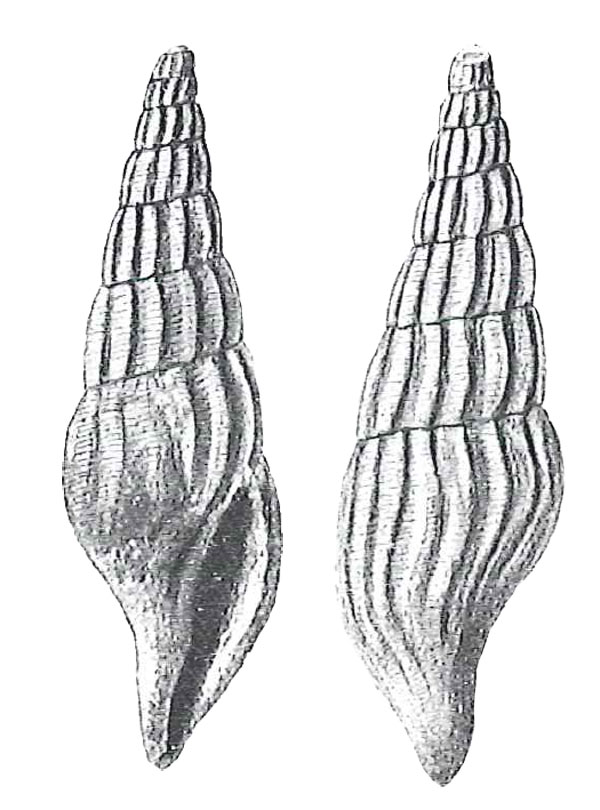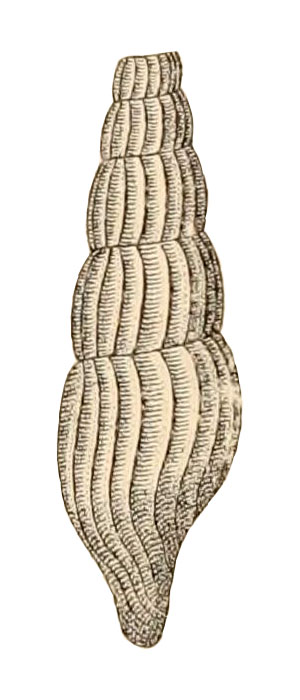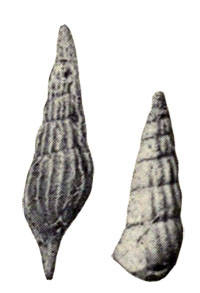|
edit SideBar
|
Species / Anchura Pergracilis
Stromboidea
Original Description of Anchura ? pergracilis by Johnson, 1898, p. 463:
- "Shell fusiform, whorls convex, the body whorl with about 18 and the spiral whorls with 15 equidistant, flexuous, longitudinal ribs; numerous fine revolving lines, more prominent between the ribs, and somewhat obsolete on the angles of the ribs, cover the entire shell; suture deeply impressed. The length of the largest specimen (including the two apical whorls, which are wanting), is about 20 mill.
Comment Johnson, 1898, p. 121:
- "I would hesitate in describing this young shell if it were possible to determine the shells of this group from the figures and description of the casts that have already been described. This species can always be determined, but in identifying casts when the external characters are unknown, there is always moie or less doubt, even when one has access to the types."
Anchura ? pergracilis Johnson, 1898, p. 463, fig. 2
History and Synonymy
1907
Description of Anchura pergracilis (Johnson, 1898) in Weller, 1907:
- "Shell fusiform, whorls convex, the body whorl with about 18 and the spiral whorls with 15 equidistant, flexuous, longitudinal ribs; numerous fine revolving lines, more prominent between the ribs and somewhat obsolete on the angles of the ribs, cover the entire shell; suture deeply impressed. The length of the largest specimen (including the two apical whorls, which are wanting), is about 20 mill."
Localities: Matawan and Mount Laurel, Burlington County, New Jersey, USA
Stratigraphy: Upper Cretaceous
Anchura pergracilis in Weller, 1907, pl. LXXXI, fig 18, 19
1926
Wade, 1926, p.151:
- "Anchura? pergracilis Johnson is well characterized by its relatively small size, very slender outline, and numerous sigmoidal costae. There are several well-preserved specimens of this species in the Coon Creek collection, but none show any signs of the expanded outer lip common to the other species of this genus. No doubt Johnson properly questioned his generic determination when he described this species, for it is very probable that this species is not a true Anchura nor a member of any of the described genera in the family Aporrhaidae but rather is a member of an un described generic group. An Eocene species, which has a simple outer lip and the same slender form together with the same characters of spiral and axial sculpture, which may belong to the same group as the Cretaceous species, has been figured by Cossmann as Rostellaria lucida Sowerby. Further study of the Upper Cretaceous and Eocene gastropods of eastern North America will perhaps throw more light on the true generic relationship of Anchura? pergracilis Johnson."
- "Occurrence: Ripley formation, Dave Weeks place on Coon Creek, McNairy County, Tenn." *"Collections: Philadelphia Academy of Natural Sciences, New Jersey Geological Survey, Maryland Geological Survey, U.S. National Museum."
- "Outside distribution: Magothy formation ("Cliff wood clay") New Jersey, Matawan group (Woodbury clay), New Jersey, Monmouth formation, Prince Georges County, Md."
 Anchura? pergracilis Wade, 1926, pl. LIII, fig. 1, 2
1960
Sohl, 1960, p. 105:
- "Anchura? pergracilis Johnson, Ripley formation (= Remera)."
1967
Sohl, 1967, p. B33:
- "The gulf coast Cretaceous species of Graphidula (Sohl, 1964) all possess stronger transverse sculpture at a later stage than G. culbertsoni, Graphidula pergracilis (Wade) being the most closely similar species. Graphidula pergacilis, however, not only retains transverse sculpture to a later stage but has wider spaced spiral sculpture and whorls that are less constricted posteriorly."
References:
|



